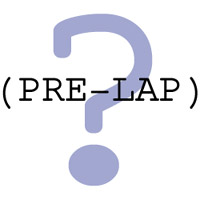 What the heck is Pre-lap?
What the heck is Pre-lap?
I had a good discussion with some of my screenwriting friends last week about using “PRE-LAP” in a script. Since many hadn’t heard the term before, I thought I’d cover it on my blog for those who may be unfamiliar with it.
John August has an excellent post on the subject, on which he succinctly defines pre-lapping as follows:
Pre-lapping is when dialogue begins before we’ve cut to the scene in which it’s spoken.
Here’s an example of how it might be used in a script:
EXT. PARKING LOT – NIGHT
Simon kisses his mistress goodnight. Looks her up and down as she sashays to her car.
WIFE’S VOICE (PRE-LAP)
Cheater!
INT. SIMON’S HOUSE – NIGHT
Guilt written all over his face, Simon gapes at his wife.
WIFE
You are totally cheating! You can’t look at all the questions first.
She hurls a plastic Trivial Pursuit pie piece at Simon’s head, revealing a board game being played with ANOTHER COUPLE. They all laugh.
SIMON
I never get away with anything.
Is it safe?
Notice how the impact of the scene(s) is dependent on the pre-lap setup? In my opinion that’s the only safe time to use it. Safe, meaning that readers should understand why you used it.
Pre-lap gets a bad rap (some readers hate it) because many writers use it simply as a stylistic choice that would be better left up to the editor of the movie.
For example, it may not be wise to use PRE-LAP for a line of dialogue spoken over a quick establishing shot, even though you see it all the time in movies and television. The editor makes that call.
In the above example, I could have used: WIFE (PRE-LAP) instead of WIFE’S VOICE (PRE-LAP). But using the latter approach is more immediately clear that we’re not seeing the character speak the line.
Here’s another example of how PRE-LAP might be used effectively:
EXT. FOREST – NIGHT
THUNK! A woman’s dead body crumples into a truck’s cargo bed.
Simon yanks a tarp over her. Climbs astride the body, holding a baseball bat. Strikes the limp figure, again and again...
FEMALE HOST’S VOICE (PRE-LAP)
The brutality of man...
INT. UNIVERSITY AMPHITHEATER – DAY
A spectacled FEMALE HOST speaks to a packed house.
FEMALE HOST
... Never before have we been given such a startling glimpse into the mind of a remorseless serial killer. It gives me great pleasure to welcome bestselling author Simon Janus to the stage.
Amidst thunderous applause, Simon strides to the podium, all smiles.
The main point I wanted to get across with the above example is how there was a juxtaposition of the action of the first scene with the dialogue of the second scene. It provides an ironic impact to the sequence.
Bottom line: If you’re going to use PRE-LAP, it has to provide an extra punch to the scene(s) that isn’t merely stylistic.
Some final thoughts
PRE-LAP is sometimes written PRELAP (without the hyphen).
Some people, like Christopher Riley in his book, The Hollywood Standard: The Complete and Authoritative Guide to Script Format and Style, advocate only using V.O. (Voice Over) and not using PRE-LAP at all. And this Wikipedia page uses O.S. (Off Screen) in conjunction with PRELAP.
In my opinion, using PRE-LAP, when appropriate, easily avoids the confusion associated with O.S. (So she’s there in the scene?), or V.O. (So she’s narrating?), and is intuitive enough that new readers unfamiliar with the term will get it.
As writers we’re taught to use the perfect word for the given situation. In these instances, I say PRE-LAP is it.
What do you think about PRE-LAP? Do you use it? Would you use it?
Want me to read your screenplay? Please take a look at my script services.





It seems both of the examples above use it to ironic effect, to emphasize a point.
I would suggest that comedic effect could be added to the list.
Even when a prelap is correctly used, don’t you think more than two or three times in a script would be a bit much?
Comedic effect, dramatic effect, surprising effect, ironic effect, dreamlike effect, memory effect… basically anything that will add impact to the scene and help to sell a moment.
I certainly wouldn’t go looking for ways to incorporate it into your script. But if it feels organic to what you need to achieve, I say go for it.
The number of times you use it totally depends. I don’t like to put hard and fast numbers on those kinds of rules. It’s never a good idea to over use any special device, whether it’s a flashback, or a montage, or a transition…
If it feels overused, within the context and style of the script, then it is. If it doesn’t, then it works.
Kurt Wimmer used PRE-LAP 7 times in his script that became the movie SALT.
Hey Trevor, awesome quote – Pre-lapping is when dialogue begins before we’ve cut to the scene in which it’s spoken – from John August.
Did yu know that John August wrote Shazam, Preacher, Wonder Woman
Have you written any superhero screenplays or do you plan to write any!
Can a screenwriter create and write his or her own super hero script
btw , YOU GOT a great blog here. One the best and very cool.
Hey Dr. Who Fan.
I haven’t written a “superhero” screenplay, but I’ve definitely written a “super powers” screenplay. When you say “superhero” in Hollywood, they immediately think pre-existing brand or property.
But if your script deals with an original character who has a unique super power, or uses them in an unconventional way, I think you have a better shot of selling your spec.
Thanks for the great feedback!
I can never remember the term PRE-LAP, thus it was in a google search I landed on this page. Thank you for the useful discussion!
I read up to a dozen specs a week in my work, and this term has NOT taken root with writers. In fact, I don’t think I’ve ever seen it in a spec (which explains why I had to look it up).
Meanwhile, I’m writing a screenplay that in the first draft it is a perfect style choice in order to keep the narrative flowing and turn multiple scenes into ongoing sequences. I may change everything in a new draft if it becomes annoying.
(Quick note: I disagree with the notion that “WIFE’S VOICE” is an acceptable character slug. A voice is not a character, even if the person whose voice we hear is never seen on screen. It’s still a person speaking. Please don’t encourage writers to use the word “VOICE” in character slugs!)
It’s true; I do see PRE-LAP used more commonly in the professional writers’ scripts that I read.
I find it interesting that you don’t like the “WIFE’S VOICE” choice. The leading Screenplay formatting books will tell you that it can be used interchangeably with: “[CHARACTER NAME] (V.O.)”
If I had just used “WIFE” it could be jarring to a reader who may think for a moment that the WIFE had been part of the scene all along. In most cases of formatting, it’s important to err on the side of clarity over perceived convention.
I definitely see the point about “jarring” the reader, though I think PRE-LAP is pretty clear. Perhaps for clarity an alternate pre-lap format style could be:
WIFE (V.O.)
(pre-lap to next scene)
Cheater!
Meanwhile, calling a person a voice jars me out of a story every time. A voice is speaking? Is it disembodied? Is it electronically generated?
There’s also the issue of cast lists. Now we have WIFE’S VOICE, WIFE & possibly even the wife’s NAME later if she becomes more important (so many writers do that). Yet in a cast list it reads as three different characters.
At least that’s my take as a reader.
I can see where you’re coming from. Using “… VOICE” is definitely something that was used more commonly in older scripts, however, it’s still equally valid.
I like the idea behind “pre-lap to next scene” but, honestly, that would be even more jarring to a reader (and format Nazi) like myself, as it’s highly non-standard (not to mention, redundant — as pre-lap implies that the voice is coming from the next scene).
There’s always monkeying that has to go on with cast lists. Sometimes you’ll have “CROWD” as a character name, with multiple simultaneous dialogue snippets. Sometimes you’ll have names that change during a script: “UNKNOWN INTRUDER” might become: “JACK” in the next scene, and use “UNKNOWN INTRUDER/JACK” for one dialogue block.
But these issues are all secondary to clarity.
This discussion does, however, highlight the importance of making your script as clean to read as possible for readers — who all have their particular sensitivities. Getting bumped once in a while during a read is almost par for the course. Getting bumped once per page is a death sentence for your script…
Unless you’re Peter Berg apparently. Have you read the script, LONE SURVIVOR? It’s up for Oscar contention and is available to download for free online. It was technically one of the most poorly written professional scripts I’ve ever read… and yet, it was also one of the most compelling scripts I’ve ever read. I wonder if that has more to do with the fact that I knew I was reading a true story.
Yeah – Most of us have heard the “if you’re Shane Black” argument (or Peter Berg in this instance). The rest of us need to get it so polished it glimmers.
I agree – your (PRE-LAP) solution seems best & clearest to me (fellow format Nazi!).
So, I’m curious. I’m looking for proper formatting for dialogue in one scene to lap over into the following scene.
For example:
From a script I am working on —
———–
She takes his arm and they exit the restaurant, looking like they’ve been together their entire lives.
JAMES NARRATING (V.O)
Have you ever seen those videos?
Of a colorblind person being given a
pair of chromatic glasses?
EXT. TENERIFE ISLAND – DAY
JAMES NARRATING (V.O) CONT’D
They are always given to someone as a surprise
by their loved ones. And they put them on,
and within seconds, they are reduced to tears
by the beauty of the most mundane things.
Things the rest of us see our entire lives. Like
the color of the sky.
James and Julie walk up a narrow trail towards a cliff top. It is a beautiful scene.
I thought PRE-LAP was the proper term. But, it’s more of a “POST-LAP”. lol. Thoughts?
Thanks for any advice.
This doesn’t work. The first thing in any scene is action. You can put the dialogue AFTER J&J walk up a narrow trail.
Lost the CONT’D – It isn’t formatted right & does not belong in a spec script. And every script is a spec until it’s greenlit.
Agreed on the action being first.
I think it would actually work as a pre-lap.
I’ve never heard about the (Cont’d) not belonging in a spec script. My software does it automatically.. I have read that it is optional though. Personally I prefer it for clarity.
Can you point me to the source of that?
Thx for the input.
C.
I do see it in Trottier’s Screenwriting Bible.
Ironically, I don’t see PRE-LAP in the index.
I mean, Trotter agrees with you.
Yup, what Tammy said (re: action lines first and cont’d).
Beyond that, Curtis, I think you’re good to go.